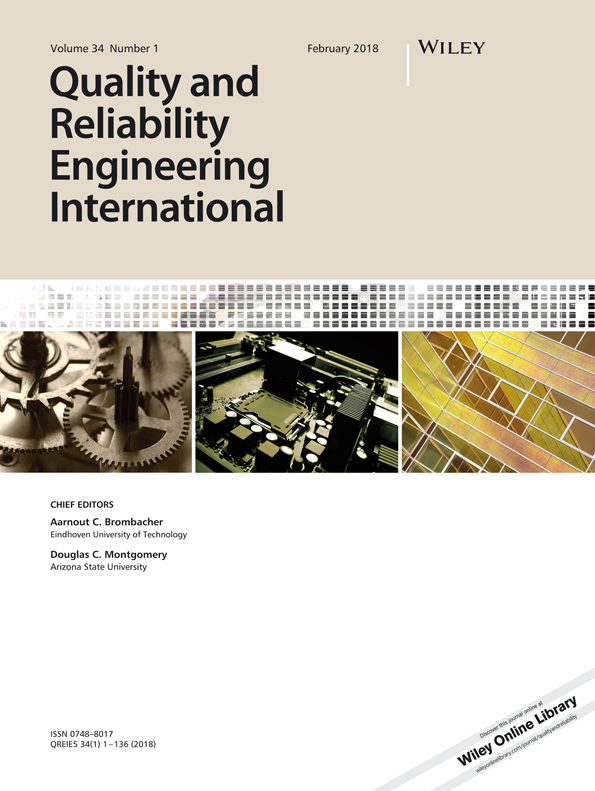On preventive maintenance under different assumptions on the failure/repair processes
Corresponding Author
Ji Hwan Cha
Department of Statistics, Ewha Womans University, Seoul, Korea
Correspondence
Ji Hwan Cha, Department of Statistics, Ewha Womans University, Seoul 120-750, Korea.
Email: [email protected]
Search for more papers by this authorMaxim Finkelstein
Department of Mathematical Statistics, University of the Free State, Bloemfontein, South Africa
ITMO University, St. Petersburg, Russia
Search for more papers by this authorCorresponding Author
Ji Hwan Cha
Department of Statistics, Ewha Womans University, Seoul, Korea
Correspondence
Ji Hwan Cha, Department of Statistics, Ewha Womans University, Seoul 120-750, Korea.
Email: [email protected]
Search for more papers by this authorMaxim Finkelstein
Department of Mathematical Statistics, University of the Free State, Bloemfontein, South Africa
ITMO University, St. Petersburg, Russia
Search for more papers by this authorAbstract
We discuss models of preventive maintenance (PM) under different assumptions on the failure/repair processes. The main emphasis is on the PM modeling under the Brown-Proschan model for minimal/perfect repairs. We also present the generalization of this model for the failure/repair process governed by the generalized Polya process. Some comparisons with conventional PM models are discussed (Nonhomogeneous Poisson process, renewal process, and geometric process of failure/repairs). Several practical examples are considered.
REFERENCES
- 1Barlow RE, Hunter L. Optimum preventive maintenance policies. Oper Res. 1960; 8: 90-100.
- 2Nakagawa T. Maintenance Theory of Reliability. London: Springer; 2005.
- 3Chenetal N. Condition-based maintenance using the inverse Gaussian degradation model. Eur J Oper Res. 2015; 243: 190-199.
- 4Levitin G, Lisnianski A. Optimization of imperfect preventive maintenance for multi-state systems. Reliab Eng Syst Safe. 2000; 67: 193-203.
- 5Lu S, Tu YC, Lu H. Predictive condition-based maintenance for continuously deteriorating systems. Qual Reliab Eng Int. 2007; 23: 71-81.
- 6Mercier S. A preventive maintenance policy with sequential checking procedure for a Markov deteriorating system. Eur J Oper Res. 2002; 147: 548-576.
- 7Mercier S, Pham HH. A preventive maintenance policy for a continuously monitored system with correlated wear indicators. Eur J Oper Res. 2012; 222: 263-271.
- 8Vaughan TS. Failure replacement and preventive maintenance spare parts ordering policy. Eur J Oper Res. 2005; 161: 183-190.
- 9Van PD, Bérenguer C. Condition-based maintenance with imperfect preventive repairs for a deteriorating production system. Qual Reliab Eng Int. 2012; 28: 624-633.
- 10Wang GJ, Zhang YL. Optimal repair-replacement policies for a system with two types of failures. Eur J Oper Res. 2013; 226: 500-506.
- 11Wang HZ, Pham H. Some maintenance models and availability imperfect maintenance in production systems. Ann Oper Res. 1999; 91: 305-318.
- 12Wang H. A survey of maintenance policies of deteriorating systems. Eur J Oper Res. 2002; 226: 469-489.
- 13Brown M, Proschan F. Imperfect repair. J Appl Probab. 1983; 20: 851-862.
- 14Block HW, Borges W, Savits TH. Age-dependent minimal repair. J Appl Probab. 1985; 22: 370-386.
- 15Cha JH. Characterization of the generalized Polya process and its applications. Adv Appl Probab. 2014; 46: 1148-1171.
- 16Cha JH, Finkelstein M. New shock models based on the generalized Polya process. Eur J Oper Res. 2016; 251: 135-141.
- 17Babykina G, Couallier V. Modelling pipe failures in water distribution systems: accounting for harmful repairs and a time-dependent covariate. International Journal of Performability Engineering. 2014; 10: 31-42.
- 18Le Gat Y. Extending the Yule process to model recurrent pipe failures in water supply networks. Urban Water J. 2014; 11: 617-630.
- 19Ross S. Stochastic Processes. New York: John Wiley; 1996.
- 20Finkelstein M. Failure Rate Modeling for Reliability and Risk. London: Springer; 2008.
- 21Beichelt FE, Fischer K. General failure model applied to preventive maintenance policies. IEEE T Reliab. 1980; 29: 39-41.
- 22Aven T, Jensen U. Stochastic Models in Reliability. New York: Springer; 1999.
10.1007/b97596 Google Scholar
- 23Finkelstein M, Cha JH. Stochastic Modelling for Reliability (Shocks, Burn-in and Heterogeneous Populations). London: Springer; 2013.
10.1007/978-1-4471-5028-2 Google Scholar
- 24Finkelstein M. A scale model of general repair. Microelectron Reliab. 1993; 33: 41-46.
- 25Lam Y. A note on the optimal replacement problem. Adv Appl Probab. 1988; 20: 479-482.
- 26Lam Y. Geometric Processes. Word Scientific: Singapore; 2007.
- 27Wang H, Pham H. Reliability and Optimal Maintenance. London: Springer; 2006.
- 28Finkelstein M. A note on converging geometric-type processes. J Appl Probab. 2007; 47: 601-607.
- 29Cha JH, Finkelstein M. Justifying the Gompertz curve of mortality via the generalized Polya process of shocks. Theor Popul Biol. 2016; 109: 54-62.
10.1016/j.tpb.2016.03.001 Google Scholar
- 30Asfaw ZG, Linqvist B. Extending minimal repair models for repairable systems: a comparison of dynamic and heterogeneous extensions of a nonhomogeneous Poisson process. Reliab Eng Syst Safe. 2015; 140: 153-158.
- 31Gertsbakh I. Reliability Theory with Applications to Preventive Maintenance. Berlin: Springer; 2005.
- 32Lim JH, Qu J, Zuo MJ. Age replacement policy based on imperfect repair with random probability. Reliab Eng Syst Safe. 2016; 149: 24-33.
- 33Beichelt FE. A unifying treatment of replacement policies with minimal repair. Nav Res Log. 1993; 40: 51-67.
- 34Yusuf B, Yusuf I, Yakasai BM. Minimal repair-replacement model for a system with two types of failure. Applied Mathematical Sciences. 2015; 9(138): 6867-6875.
- 35Finkelstein M, Shafiee M, Kotchap AN. Classical optimal replacement strategies revisited. IEEE T Reliab. 2016; 65: 540-546.
- 36Lee H, Cha, JH. A new maintenance modelling and optimization based on a generalized repair process, submitted manuscript 2016.
- 37Cha JH, Mi J. Study of a stochastic failure model in a random environment. J Appl Probab. 2007; 44: 151-163.




